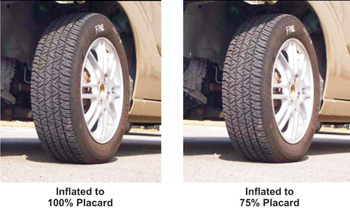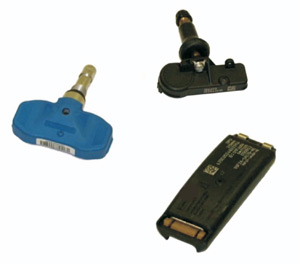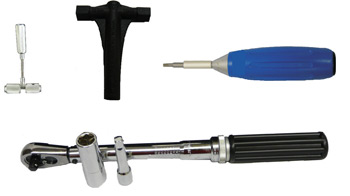By Scot Holloway
 What do you think when you hear TPMS? The acronym for Tire Pressure Monitoring Systems typically invokes less than favorable responses (and facial expressions). By now, however, most are reconciled to the fact that TPMS is here to stay. As many have already faced the “now what?” moment, it’s time for the automotive aftermarket to do what it does best…embrace the technology and provide the best service to its customers.
What do you think when you hear TPMS? The acronym for Tire Pressure Monitoring Systems typically invokes less than favorable responses (and facial expressions). By now, however, most are reconciled to the fact that TPMS is here to stay. As many have already faced the “now what?” moment, it’s time for the automotive aftermarket to do what it does best…embrace the technology and provide the best service to its customers.
TPMS…A Quick Review
It has been more than 10 years since the National Highway Traffic Safety Administration (NHTSA) began to study the safety benefits of properly inflated tires. As the NHTSA study concluded and right about the time a popular automotive manufacturer was experiencing “roll over issues,” it was determined that a great many people do not properly service their tires. It was also clear that improper tire pressure leads to tire overheating and, ultimately, tire failure.
So, after much debate, President Clinton signed the TREAD act and TPMS on production vehicles was now the mandate. The law requires that any passenger vehicle and light truck (under 10,000 lbs.) shall have a tire pressure monitoring system. After a phased introduction, 100% compliance took effect with model year 2008 (Sept. 1, 2007). It is estimated that there are now more than 44 million vehicles on the road with TPMS.

The great majority of vehicles use Direct TPMS. Direct Tire Pressure Monitoring Systems have a number of components including wheel sensors, an antenna, a receiver and a control module. The wheel sensors are located inside the wheel and tire assembly. The TPMS sensor is usually part of, or attached to, the valve stem. In some models, the TPMS sensor is banded to the drop center. In either case, the sensors work in a similar manner.
Complete with a processor, power supply and a transmitter, these “miniature computers” sample pressure and temperature inside the wheel and then periodically transmit the data back to the vehicle’s receiver. Once received, the data is decoded and processed by a control module. When a low-pressure condition is detected, a warning indication is made on the instrument panel. Some vehicles have a warning light, while others display pressure. All vehicles must indicate a warning when pressure is low. Typically, a solid light is a pressure problem and a flashing light is indicative of a system problem.
Why TPMS?
Why have such a system, why TPMS? As NHTSA concluded, many consumers do not regularly check their tire pressure. There are many factors to consider with a low tire pressure situation, not the least of which is safety. Underinflated tires roll at higher temperatures, handle poorly and require longer vehicle stopping distances. Underinflated tires also reduce gas mileage. There are also economic factors. As fuel prices rise, it becomes increasingly important to do everything possible to increase vehicle gas mileage. Properly inflated tires help get better fuel economy. Finally, properly maintained tire pressure maximizes tire life.
The reality is that properly inflated tires, monitored by a properly maintained TPMS, help to make the vehicle safer and save consumers money. Since it is believed that the system (including the sensors) may last as long or longer than three sets of tires, the value to maintaining them is high and will save the consumer considerable operating cost over the life of the vehicle.
Embrace the Opportunity
It is said that “change is inevitable but growth is intentional.” TPMS presents that same fork in the road. TPMS is an opportunity to grow your business and offer enhanced services to your customers; or, if ignored, let your competition take your customers.
Automotive repair facilities and tire dealers alike have a great opportunity to show existing and potential customers that they can solve their problems. With TPMS there are new components to sell and service, more diagnostics to sell and technical problems to solve. Get a better understanding of the technology, what replacement components are involved and which tools are required. Most importantly, align yourself with a supplier that can provide real customer support. By embracing TPMS, you can set your business apart from the competition.

Knowledge Is Power
If you take anything away from this article it is this: TPMS can be complex and there is plenty of information (and mis-information) available. The Internet is full of sources for TPMS research. When researching TPMS, you can learn what tools are required and how they work. It is a good idea to research all the tools that are available and get an understanding of how TPMS tools work.
There are mechanical tools like torque wrenches, valve core tools and grommet tools. There are also electronic tools to test the sensors and reprogram the vehicle. It is important to note that the cheapest tool isn’t always the best solution, especially when you consider the complexity of the repair process. Many vehicles require an OBD connection to complete a TPMS re-learn. This requires an electronic tool that has been engineered and tested thoroughly and, more importantly, is easy to operate.
There are many aspects to an electronic TPMS tool. Most notable are the ability to activate the TPMS sensor, change the sensor mode, if necessary, receive and decode the sensor transmission, and program the vehicle. If the TPMS tool adds confusion or creates problems, the technician will end up spending more time than necessary on the repair, or worse — not be able to complete the repair at all!
Arming yourself with the right tools isn’t always enough. A fundamental understanding of the sensor’s function and vehicle applications goes a long way in troubleshooting TPMS issues. It is important that you have access to the very best in training and technical support. Align yourself with resources that provide training, technical support, answer tough TPMS questions and assist your technicians through difficult TPMS problems.
Make the Investment
Once you have completed the necessary research and you are now your company’s resident expert — it’s time to act! It’s important to remember, TPMS is about maintenance. Keep the system operational and the consumer can realize the intended benefits (safety, fuel economy and extended tire life).
As you have learned, to do this you need service packs, replacement sensors, the proper valve cores and caps…and, more importantly, the right tools. Having these items in stock means you can service your customer quickly and accurately. Many suppliers of sensors and service packs can assist in managing your inventory and help you keep the right part numbers in stock.
Get the Word Out
Develop a strategy that gets the word out. Educate your customers on the new services you provide. Let them know that your repair technicians are trained and educated in TPMS. Spread the word that your business has invested in this training, the necessary tools and has the right parts in stock to properly service their vehicles. This is especially important in these days as many vehicle owners are looking for an alternative service provider since their dealer may have closed.
Yes, TPMS is relatively new, difficult and oftentimes a source of major frustration, but these challenges are no match for the creativity and the ingenuity of the U.S. automotive aftermarket. Take advantage of the available resources and don’t go it alone. In tough economic times, it becomes even more critical to do whatever is necessary to keep the customers we have and find ways to attract new ones. As founding father Thomas Paine once said, “Lead, follow, or get out of the way.” It is time to lead.
Scot Holloway is the general manager of Bartec USA, LLC. Bartec USA and the Bartec Group of companies have long been experts in TPMS. With more than 80 TPMS installations worldwide, Bartec programs the TPMS of all varieties of makes and models. Visit www.bartecusa.com for more information on Bartec USA and Bartec Auto ID.








